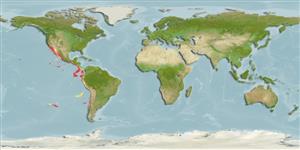Common names from other countries
Holocephali (chimaeras) >
Chimaeriformes (Chimaeras) >
Chimaeridae (Shortnose chimaeras or ratfishes)
Etymology: Hydrolagus: hydro-, combining form of hydor (Gr.), water; lagos (Gr.), hare, i.e., “water rabbit,” probably referring to three pairs of tooth plates, which tend to protrude from the mouth like a rabbit’s incisors. (See ETYFish); melanophasma: melanos (Gr.), black, referring to color in life; phasma (Gr.), ghost or specter, alluding to the vernacular “ghostshark” (literally, a black ghost). (See ETYFish).
Environment: milieu / climate zone / depth range / distribution range
Ecology
Marine; bathydemersal; depth range 2 - 1720 m (Ref. 93040), usually 565 - 1720 m (Ref. 93040). Subtropical; 35°N - 40°S, 125°W - 70°W (Ref. 93040)
Eastern Pacific Ocean: From Baja California, Mexico to Validivia, Chile.
Size / Weight / Age
Maturity: Lm ? range ? - ? cm
Max length : 120 cm TL male/unsexed; (Ref. 82286)
A species of the genus Hydrolagus based on the absence of an anal fin. Hydrolagus
melanophasma sp. nov. is distinguished from other chimaeroids by a blunt snout with minimal sloping from the orbit to the snout tip, a large slightly curved dorsal fin spine (25.9 % BDL) extending beyond first dorsal fin apex, and a long second dorsal fin (77.3–81.1% BDL) of uniform height throughout. The pectoral fins are large, reaching beyond the pelvic fin insertion when laid flat, trifid claspers forked for 27–27.8% of the total clasper length and the preopercular and oral lateral line canals branch separately or together from the infraorbital canal. Coloration after preservation is a uniform black with no distinct mottling or markings (Ref. 82286).
Life cycle and mating behavior
Maturities | Reproduction | Spawnings | Egg(s) | Fecundities | Larvae
James, K.C., D.A. Ebert, D.J. Long and D.A. Didier, 2009. A new species of chimaera, Hydrolagus melanophasma sp. nov. (Chondrichthyes: Chimaeriformes: Chimaeridae), from the eastern North Pacific. Zootaxa 2218:59-68. (Ref. 82286)
IUCN Red List Status (Ref. 130435)
CITES (Ref. 128078)
Not Evaluated
Threat to humans
Harmless
Human uses
Tools
Special reports
Download XML
Internet sources
Estimates based on models
Preferred temperature (Ref.
115969): 2.6 - 6.5, mean 3.9 (based on 154 cells).
Phylogenetic diversity index (Ref.
82804): PD
50 = 0.5000 [Uniqueness, from 0.5 = low to 2.0 = high].
Bayesian length-weight: a=0.00282 (0.00118 - 0.00673), b=3.10 (2.89 - 3.31), in cm Total Length, based on LWR estimates for this (Sub)family-body shape (Ref.
93245).
Trophic level (Ref.
69278): 4.0 ±0.6 se; based on size and trophs of closest relatives
Resilience (Ref.
120179): Very Low, minimum population doubling time more than 14 years (Preliminary K or Fecundity.).
Fishing Vulnerability (Ref.
59153): High to very high vulnerability (72 of 100).
